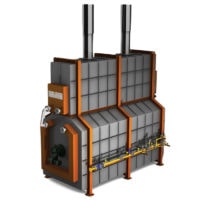5 Industrial Applications for Direct Fired Heaters (API 560 & Non API)

Direct fired heaters use one of three possible methods for heat transfer:
- Radiant-convective heat
- Radiant heat
- Convection heat
Radiant–convective style direct fired heaters are a popular style of heater and are used more often than not. These heaters utilize a bare tube radiant zone in combination with a bare / finned convection section. The most typical configurations are vertical cylindrical, A-frame, and cabin style. Sigma Thermal offers all types of direct fired radiant–convective heater designs including API 560 compliant systems.
Convection style direct fired heaters provide the benefits of a direct-fired heater, but eliminates some of the drawbacks associated with radiant heat transfer. In specific temperature-sensitive applications, radiant heat transfer can be undesirable, as radiant heat transfer tends to be more harsh and unevenly distributed around the coil surface. To minimize the impact effect of the radiant heat transfer to the process coil, Sigma Thermal’s convection style direct fired heaters are designed to utilize a separate combustion chamber and flue gas recirculation. With this design, the combustion chamber temperatures are reduced to 1,400°F.
API 560 Heaters vs Non API Heaters
Convection or radiant-convective direct-fired heaters can be designed using API RP 560 guidelines and practices created for fired heaters used for general refinery service. These guidelines are established by the American Petroleum Institute (API). Typically if the application involves the direct heating of crude oil, API560/ISO 13705 standard design guidelines will apply. For almost all other applications (i.e. regeneration gas, thermal oil heating, water, glycol, and temperature gases), more optimal designs are available that lower the capital and installed cost, footprint, fabrication, installation time, and freight cost. A practical strategy to use to obtain an API-style design, without incurring unnecessary costs for irrelevant design elements (that are not useful for some applications), is to use API 560 as a guideline with key exceptions.
5 Applications for Direct Fired Heaters
Regeneration Gas Heating
Regeneration gas heaters remove unwanted moisture from high-temperature process streams, such as natural gas. The wet gas runs through a desiccant-style or molecular sieve bed drying system that captures moisture from the fluid stream, leaving a purer form of the gas that is ready for additional processing and storage. The regeneration gas heater then dries the desiccant so it can be reused. Regeneration gas heating systems are also common in air separation facilities, where water and carbon dioxide are removed from the surrounding air, allowing air to be cooled into a liquid.
Process Air Heating
Process air heating, in combustion turbine systems, improves combustion ability and the reliability of the system. Process air heating also temperature control for process air, either at specific locations or facility-wide. Common examples of this type of heater include water-glycol systems and thermal oil systems. Robust, reliable, and long-lasting, process air heating systems see frequent use for precision temperature control in commercial food processing ovens and feeding heated air into industrial process consumers.
Viscosity Reduction
Heating heavy liquids reduces their viscosity, reducing the level of power required to pump and transport them in process systems and pipelines. This process has become common to facilitate easier transportation of crude oil and its various derivatives. Overheating crude oil will damage it and reduce its quality, making precision control essential during viscosity reduction processes.
Skid-mounted indirect heating systems are often used near oil wells in remote locations, offering precision temperature control by heating oil through a heating medium. Some operations also use direct oil heating, which can be managed properly using low watt-density electric heating elements and convection-only style direct-fired heaters.
Inline Liquid or Gas Heating
In opposition to tank heaters or full process system heaters, inline heaters provide heat for fluids at a specific point in a process, making the fluid ready for its intended purpose. By only heating the gas or liquid that’s immediately needed, users significantly reduce energy consumption and associated expenses. Inline heaters may be either direct-fired or electric, depending on their intended application.
Thermal Oil Heating
Thermal oil heating systems provide indirect heating using thermal oil as a heat transfer medium. Thermal oil provides an ideal medium for high-temperature operation, facilitating temperatures up to 600°F with organic oils, or up to 800°F with synthetic oils. Thermal oil heating has broad applications, including reboilers, tank heating, press heating, and numerous other industrial use cases. Thermal oil heating systems work well for processes that require high-temperature operation and precision control.
Sigma Thermal Solutions
The above guide demonstrates the impressive versatility of direct fired heating systems. Whether you need to design a unit to suit one of the applications we’ve discussed here or an entirely new purpose, Sigma Thermal Solutions can produce direct fired heaters customized to your demands. Our business serves customers from an array of industries, including aerospace, agriculture, automotive manufacturing, chemical processing, food processing, gas production, mining, oil processing, power generation, paper manufacturing, wastewater processing, and more.
Our signature Sigma Thermal convection-style, API 560, and non-API radiant-convective heaters range from 1MM to 80 MM BTU per hour. To learn more about ordering direct fired heaters, contact an expert from Sigma Thermal Solutions today.
Sigma Thermal Solutions was founded on the belief there are three keys to success: exceptional engineering knowledge, practical field experience, and honest customer service. We look forward to helping you fulfill all your company’s heating needs!






